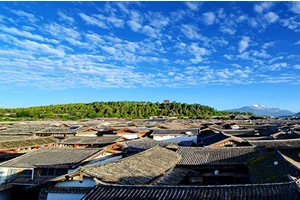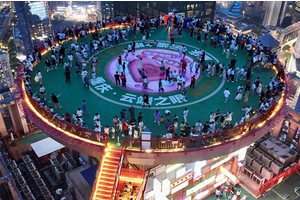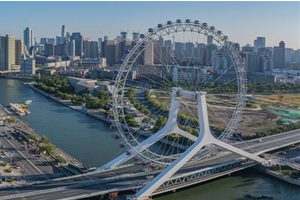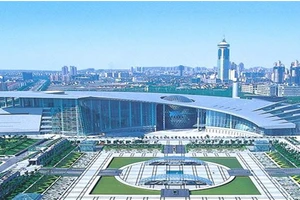Foshan tourist attractions daquan ranking
Introduction of ten famous scenic spots that Foshan must visit.
Foshan is not only the hometown of martial arts, but also an ancient cultural city with a thousand-year history and a unique Lingnan water town. The following are the top ten scenic spots that I have collected and sorted out, and I hope it will help you.
Ten scenic spots that Foshan must visit.
A must-see spot for Foshan tourism 1. Xiqiao Mountain
Xiqiao Mountain is located in the southwest of Nanhai District, Foshan City, Guangdong Province. It is an ancient volcano and is known as the "beacon of Pearl River civilization". The natural scenery on the mountain is beautiful. The most famous scenic spots in the mountain are Baiyun Cave Yunquan Fairy Hall and Baofeng Temple. Xiqiao Mountain also has its special food-Xiqiao pie. Because the cake is shaped like a full moon, which means that it is a good intention to spend a full moon, Xiqiao people use it as a gift for weddings and celebrations. Yunquan Fairy Hall, originally Yulou Academy, was built according to the mountain situation. Exquisite brick carvings in the Qing Dynasty, statues of Shuanglong grabbing pearls, murals of hundreds of birds facing the phoenix, etc. are all key cultural relics in the museum. As one of the main producing areas of brick carvings in Guangdong, Foshan is rare to see such well-preserved brick carvings in the Qing Dynasty as Yunquan Fairy Museum.
A must-see spot for Foshan tourism 2. Huang Feihong Memorial Hall
Huang Feihong Memorial Hall is located in the center of Foshan, just to the north of the famous tourist attraction-Zumiao, with a total area of more than 5,000 square meters. The display in the museum introduces Huang Feihong's life story, and comprehensively displays all kinds of literary and artistic works and thousands of precious cultural relics around Huang Feihong in the past 70 years. The architectural style of Huang Feihong Memorial Hall is typical of China's ancient architectural style. Each brick and tile highlights the tradition and style of Lingnan ancient buildings, while preserving the courtyard-style architectural norms of traditional houses. The architectural components of the memorial hall, such as beams, pillars, brick carvings, cornices, screens, doors and windows, railings, etc., are all made use of the old materials collected, so that visitors can really feel the traces of history and the charm of Lingnan.
A must-see spot for Foshan tourism 3. Foshan ancestral temple
Foshan Ancestral Temple is located in Chancheng District, Foshan City, Guangdong Province. It was built in Yuanfeng period of the Northern Song Dynasty and gradually became a temple building with complete system, rigorous structure and strong local characteristics in the early Qing Dynasty. Ceramic sculpture, wood carving, brick carving, gray sculpture and so on are widely used in the architectural decoration of the ancestral temple, and its overall layout is regular and solemn, dense and elegant. The setting of pavilions and pavilions strictly abides by the principles of ancient garden architecture in China, and the ingenious dialectics of hiding and revealing makes tourists feel that its internal space is subtle, introverted, complex and mysterious, which in turn leads to a sense of awe. Most people in Chancheng like to get married two or three months before the Lunar New Year. When visiting the ancestral temple in winter, you can often see the spectacular scenes of more than a dozen couples saluting at the same time. There are different surprises when you visit the ancestral temple all year round.
A must-see spot for Foshan tourism 4. Qinghui Garden
Qinghui Garden is located in Huagaili, daliang town, Shunde District, Foshan City, Guangdong Province. It is a masterpiece of classical garden art in southern China. It is known as one of the four famous gardens in Lingnan and has been listed as a provincial-level cultural relics protection unit. Its layout can not only absorb the essence of Suzhou garden art, but also adapt to local conditions. The environment is famous for its quiet nature, beauty and elegance. The name of the garden is "qinghui", which means warm and sunny sunshine, which means the kindness of parents. The gardens were built many times by five generations, including On Behalf Oflong Yingshi, Long Tinghuai, Long Yuanren, Long Jingcan and Long Zhuhui, and gradually formed a Lingnan garden with complete pattern and rich characteristics.
A must-see spot for Foshan tourism 5. Ninjuji.
Ninjuji is one of the four jungles of Buddhism in the Qing Dynasty in Foshan. It is located at No.5 Zumiao Road, Chancheng District, Foshan, only a few hundred meters away from the ancestral temple in Foshan. It is the seat of Foshan Buddhist Association. Founded in the 13th year of Shunzhi in Qing Dynasty (1656), it was founded by the great monk of Tantric Zongtang in guanyin temple Pufo Mountain. After three hundred and fifty-five years, Zen master Yulin Tongyu, a Buddhist teacher during the Shunzhi period, presided over fund-raising and rebuilt the mountain gate in the eighth year of Kangxi in Qing Dynasty (1669). During the Daoguang-year period, due to the lack of food for monks in Ninjuji, the abbot of Hualin Temple in Guangzhou, Renji (Gion), was invited by Foshan officials to raise funds to rebuild Ninjuji. By the first year of Xianfeng (1851), the project was completed.
Click the next page to see the scenic spots that Foshan must visit.
Guangzhou Foshan tourist guide scenic spots must be visited.
The scenic spots that Guangzhou Foshan must visit are: Foshan Liangyuan, Nanfeng Ancient Stove, Nanhai Film and Television City, Shunfengshan Park and Fengjian Water Town.
1. Foshan Liangyuan: Foshan is a "Lingnan Heaven and Earth", with ancient Lingnan buildings all over Foshan. However, Foshan Liangyuan has formed a typical Lingnan architectural style through the construction of four uncles, including Ai Liaing Ru, Liang Jiutu, Liang Jiuzhang and Liang Jiuhua. It is also a masterpiece of Lingnan Garden, with pavilions, pavilions, paths, small bridges, flowing water and exotic flowers and plants, forming houses, ancestral halls and gardens.
2. Nanfeng Ancient Stove: Speaking of Nanfeng Ancient Stove, we have to talk about Shiwan first. It is an important pottery base in Lingnan in China history and is known as the "Tao Dou of the South". Nanfeng Ancient Stove is located in Gaomiao Road, Shiwan Town, Foshan. It was built in 1506 and has a history of more than 500 years. Here, we can not only learn about pottery culture, but also participate in playing and burning pottery, which is a great opportunity for pottery lovers and children to exert their artistic potential.
3. Nanhai Film and Television City: Nanhai Film and Television City is a film and television production base directly under CCTV, and it is also one of the tourist and leisure resorts in the hinterland of the Pearl River Delta where natural conditions have not been artificially destroyed and polluted. Since 1997, it has welcomed more than 500 film crews and interpreted countless classic film and television stories, laying a deep foundation for film and television culture. As long as you are in Nanhai Film and Television City, you will find that the beautiful painting style in Rain Lane originated from the small bridge and flowing water in Suzhou Street, and you are full of sense of the times when you travel here.
4. Shunfengshan Park: Shunfengshan Park is a modern tourist attraction integrating tourism, leisure and entertainment. It not only has real mountains and water, but also has a rich cultural and historical background, forming a natural and cultural landscape pattern of "green mountains, clear water, one temple, two lakes and two towers". In Tingzhi Building on the Qingyun Lake in Shunfengshan Park, light a latte, sit quietly outdoors and enjoy the beautiful scenery along the lake. The breeze blows away the rich coffee fragrance, refreshing people and feeling the "poetry and distance" in the city.
5. Fengjian Water Town: Fengjian Water Town is a must in Lingnan Water Town and is known as "Zhouzhuang, Guangdong". Here, the air is fresh, the environment is natural and harmonious, the century-old houses standing on both sides of the street, the winding rivers, the ancestral temples and private schools that exude books, present a tree-lined place in front of us, birds and flowers, and a poetic scene. Walking on the ancient streets of water towns, the cultural heritage and life atmosphere here suddenly make you stay away from the hustle and bustle of the city, clear your mind, forget your troubles and return your mind to peace.
The above contents refer to Baidu Encyclopedia-Foshan Liangyuan Baidu Encyclopedia-Fengjian Water Town.
Ten scenic spots that Foshan must visit.
Ten scenic spots that Foshan must visit:
1. Xiqiao Mountain
Xiqiao Mountain is one of the four famous mountains in Guangdong, with beautiful natural scenery, rich tourism culture and simple folk customs. Xiqiao Mountain has beautiful natural scenery, with 72 peaks and odd peaks, 42 caves and caves, 36 caves, 232 clear springs, 28 waterfalls, and lakes, waterfalls, springs, streams, rocks, walls, ponds and terraces.
Since the Ming and Qing Dynasties, scholars, talented people and travelers have come in droves, making the beautiful Xiqiao Mountain a famous tourist attraction in South Guangdong, and also known as the "beacon of Pearl River civilization", which is one of the most famous scenic spots in Foshan.
2. Changlu Tourism Xiubo Park
Changlu Tourism Leisure Expo Park is a comprehensive scenic spot featuring Lingnan history and culture, Shunde water town customs and farmers' life interest, which integrates eating, living, playing, enjoying, entertaining and shopping. It is mainly composed of Changlu Leisure Resort, Motorized Amusement Theme Park, Water World Theme Park, Nongjiale Theme Park, Ocean Theme Park and Animal Theme Park.
It has its own characteristics and is colorful, and it is a good place for young people to have fun and travel. The scenic spot has also won the national agricultural tourism demonstration site, which is a resounding tourist business card of Foshan and a famous tourist scenic spot in Foshan.
3. Qinghui Garden
Qinghui Garden is an ancient garden building that was built in the Ming Dynasty. It is also known as the four famous gardens in Guangdong in the Qing Dynasty with Foshan Liangyuan, Panyu Yuyin Shanfang and Dongguan Keyuan, ranking first among the four famous gardens in Guangdong. It is also the new eight scenic spots in Foshan and the new ten scenic spots in Shunde. It is a historical and cultural business card for Shunde to publicize and show its own cultural connotation. It is also a resounding tourist cultural business card in Foshan and one of the most famous scenic spots in Foshan.
Qinghui Garden is a masterpiece of Lingnan gardens, which integrates Ming and Qing culture, Lingnan ancient garden architecture, Jiangnan garden art and the characteristics of the Pearl River Delta water town. It integrates ancient Chinese architecture, gardens, sculpture, poetry books, gray sculpture and other arts, and is a picturesque and dreamlike charming resort.
4. Ancestral Temple
Foshan Ancestral Temple was built in Yuanfeng period of Northern Song Dynasty and rebuilt in Hongwu period of Ming Dynasty. It is a folk-custom ancient building complex integrating ancient building art of Ming and Qing Dynasties and traditional culture of Foshan. Together with Longmu Temple in Yuecheng, Zhaoqing and Chenjiaci in Guangzhou, it is called the three treasures of ancient buildings in Lingnan, praised by foreign friends as the "Palace of Oriental Folk Art" and is now the fourth batch of national key cultural relics protection units.
5. Nanfeng ancient stove
Nanfeng ancient stove tourist area is a scenic spot built around key cultural relics protection units such as Nanfeng stove, Gaozao, Gaomiao and Linjiating.
In the scenic spot, the essence of traditional crafts, such as mountain male micro-carving, drawing blanks with ancient cars, patting vats and beating straw sandals, and the essence of folk art, such as lion dance, martial arts, Cantonese opera and paper-cutting, are gathered. Every day, a large number of people from all over the world are attracted to look for the roots and souls of pottery in this holy place of world pottery culture and experience the profound China culture.
Known as the "living fossils of ceramics", Nanfeng ancient stoves and high stoves have been fired endlessly and produced continuously for 500 years, which is rare in the world. They have been included in the Guinness Book of World Records and were recognized as the third batch of national industrial heritage in 2019. In addition to sightseeing, tourists can also participate in playing and burning pottery.
Free attractions worth visiting in Foshan
Free attractions worth visiting in Foshan:
1. Nanhai Film and Television City
CCTV Nanhai Film and Television City is one of the four film and television production bases directly under CCTV. Located in Songgang Town, Nanhai City, Guangdong Province, it covers an area of over 1,500 mu. Here, the slope is gentle and low, the lake is rippling, the mountains are fresh, the style is elegant and full of interest.
2. Shunde Changlu Farm
It is a comprehensive scenic spot featuring Lingnan history and culture, Shunde water town customs and farm life interest, which integrates eating, living, playing, enjoying, entertaining and shopping. It is mainly composed of five parks: Changlu Leisure Resort, Motorized Amusement Theme Park, Water World Theme Park, Nongjiale Theme Park and Animal Theme Park.
3. Foshan ancestral temple
Foshan ancestral temple is located in Chancheng District, Foshan City, Guangdong Province. It was built in Yuanfeng period of Northern Song Dynasty (1078-1085) and rebuilt in Hongwu period of Ming Dynasty (1372). By the early years of Qing Dynasty, it gradually became a temple building with complete system, rigorous structure and strong local characteristics. In the 25th year of Guangxu (1899), the ancestral temple was overhauled, forming today's ancestral temple complex.
4. Jade Street in Pingzhou
Pingzhou Jade Street is located in Yong 'an Road, Guicheng Street, Nanhai District, Foshan City, Guangdong Province. It is quite famous in the industry, with the largest production and sales volume in the country, ranking first among the four major jade markets in the country, and is well-known for processing jadeite A goods.
5. Xiqiao Mountain
Xiqiao Mountain Scenic Area is one of the four famous mountains in Guangdong, and enjoys the honors of national AAAAA-level tourist attractions, China National Forest Park, China National Geopark, national key scenic spots and "Beacon of Pearl River Civilization". Xiqiao Mountain is located in the southwest of Nanhai District, Foshan City, Guangdong Province, China.
[img]
The top ten scenic spots that Foshan must visit are Xiqiao Mountain, Changlu Tourism Xiubo Garden, Qinghui Garden, Foshan Ancestral Temple, Nanfeng Guzao Tourist Area, Nanguo Taoyuan Tourist Resort, soap screen hill, Chencun Flower World, Sanshui Lotus World and Yingxiang Ecological Park.
1. Xiqiao Mountain
Xiqiao Mountain is one of the four famous mountains in Guangdong, with beautiful natural scenery, rich tourism culture and simple folk customs. Xiqiao Mountain has beautiful natural scenery, with 72 peaks and odd peaks, 42 caves and caves, 36 caves, 232 clear springs, 28 waterfalls, and lakes, waterfalls, springs, streams, rocks, walls, ponds and terraces.
2. Changlu Tourism Xiubo Park
Changlu Tourism Leisure Expo Park is a comprehensive scenic spot featuring Lingnan history and culture, Shunde water town customs and farm life interests, and integrating eating, living, playing, enjoying, entertaining and shopping.
3. Qinghui Garden
Qinghui Garden is a masterpiece of Lingnan gardens, which integrates Ming and Qing culture, Lingnan ancient garden architecture, Jiangnan garden art and the characteristics of the Pearl River Delta water town. It integrates ancient Chinese architecture, gardens, sculpture, poetry books, gray sculpture and other arts, and is a picturesque and dreamlike charming resort.
4. Foshan ancestral temple
Foshan ancestral temple was built in Yuanfeng period of the Northern Song Dynasty and rebuilt in Hongwu period of the Ming Dynasty. It is a folk-custom ancient architectural complex that combines the ancient architectural art of Ming and Qing Dynasties and the traditional culture of Foshan.
5. Nanfeng Guzao Tourist Area
Nanfeng ancient stove tourist area is a scenic spot built around key cultural relics protection units such as Nanfeng stove, Gaozao, Gaomiao and Linjiating.
6. Southern Taoyuan Tourist Resort
Nanguo Taoyuan Tourist Resort is one of the new eight scenic spots in Foshan and the famous hometown of peach blossoms in Guangdong. There are three scenic spots in the scenic area: Nanhai Kannonji, Nanhai Film and Television City and Bibo Lake Heron Paradise, which make Nanguo Taoyuan a famous tourist attraction.
7. soap screen hill
The main peak of soap screen hill is 804.5 meters above sea level, which is the highest peak in Foshan. The mountain is steep, the mountains fluctuate one after another, and the scenery is charming. At the top of the mountain, you can enjoy the mountains and feel the tolerance and mind of "the other mountains all appear dwarfs under the sky.", so it is called "the first peak in Foshan" and is one of the famous scenic spots in Foshan.
8. Chencun Flower World
Chencun Flower World is a famous flower town in Lingnan, with a history of more than 2,000 years of flower planting. It is known as "the Millennium Flower Town in Lingnan" and "the first flower town in China", and it is the flower sea spectacle of the new eight scenic spots in Foshan.
9. Sanshui Lotus World
Sanshui Lotus World is a large-scale lotus viewing scenic spot in the world with rich variety resources, integrating architecture, sculpture, Dutch, mobile games, hotels and restaurants. It is the most famous summer lotus viewing resort in Foshan.
10. Yingxiang Ecological Park
Yingxiang Ecological Park is located at the foot of Lingyun Mountain, Gaoming District, Foshan City, which is known as Jiuzhaigou in the Pearl River Delta. The park covers an area of 3,000 mu. The facilities in the park mainly include Lingyun Feidu Glass Bridge, Water Park, Hundred Mu Flower Sea, Popular Science Kingdom, Happy Farm, Screaming Happy World, Happy Ranch, Shake Paradise, Rainbow Slide, Picnic Barbecue and Handwritten Store.
Reference to the above content: Baidu Encyclopedia-Yingxiang Ecological Park






